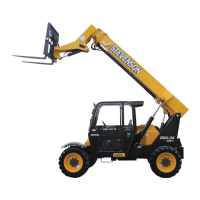PRINTED IN U.S.A. 23 913323/CP0112
Alternator Lamp: Located in the
upper left section of the lamp
cluster gauge, this lamp indi-
cates the condition of the electri-
cal charging system. During nor-
mal operation, this lamp should
be off. If the charge rate is too high
or too low, this lamp will come on.
Engine Oil Pressure Lamp:
Located in the upper right section
of the lamp cluster gauge, this
lamp indicates whether the
engine lubricating oil pressure is
sufficient. During normal opera-
tion, with the engine running, this
lamp should be off. During starting and
when the engine is not running, this lamp will be on.
IMPORTANT: If this lamp comes on during nor-
mal operation with the engine running, stop the
engine immediately! After allowing the oil to drain
down for a few minutes, check the engine oil
level. Maintain oil level at the FULL mark on the
dipstick.
Brake Failure Lamp: Located in
the lower left section of the lamp
cluster gauge, this lamp indicates
the condition of the service
brake system. The front and rear
brakes are on independent sys-
tems. If a loss of pressure occurs in
either system during normal operation
with the brake pedal depressed, this lamp will come on.
Failure in one of the brake systems does not affect the
operation of the other system. However, the MANDA-
TORY SAFETY SHUTDOWN PROCEDURE (p. 8)
should be followed and any necessary repairs made
immediately.
During normal operation this lamp should remain off.
Transmission Oil Temperature
Lamp: Located in the lower right
section of the lamp cluster
gauge, this lamp indicates
whether or not the transmission
oil is at the proper temperature.
During normal operation this lamp
should be off, indicating that the trans-
mission oil system is at the proper temperature.
IMPORTANT: If this lamp comes on during nor-
mal operation, a problem may exist in the trans-
mission oil system. Stop the machine immediate-
ly and investigate the cause of the problem!
Top Row Switches
Switches have graphic symbols to indicate function
and effect. The following descriptions start with the
first switch on the left.
A - Steering Mode: This 3-position switch is used to
select among the three steering modes. The upper posi-
tion engages the 4-wheel-steer mode. This mode pro-
vides all-wheel steering, used for making tighter turns,
usually on a jobsite. The center position engages the 2-
wheel-steer mode. This mode provides front-wheel
steering only, used for higher speed travel. The lower
position engages the crab-steer mode. This mode is
used when a small amount of side shift is needed for
picking or placing a load.
Switch Panel
A B C

